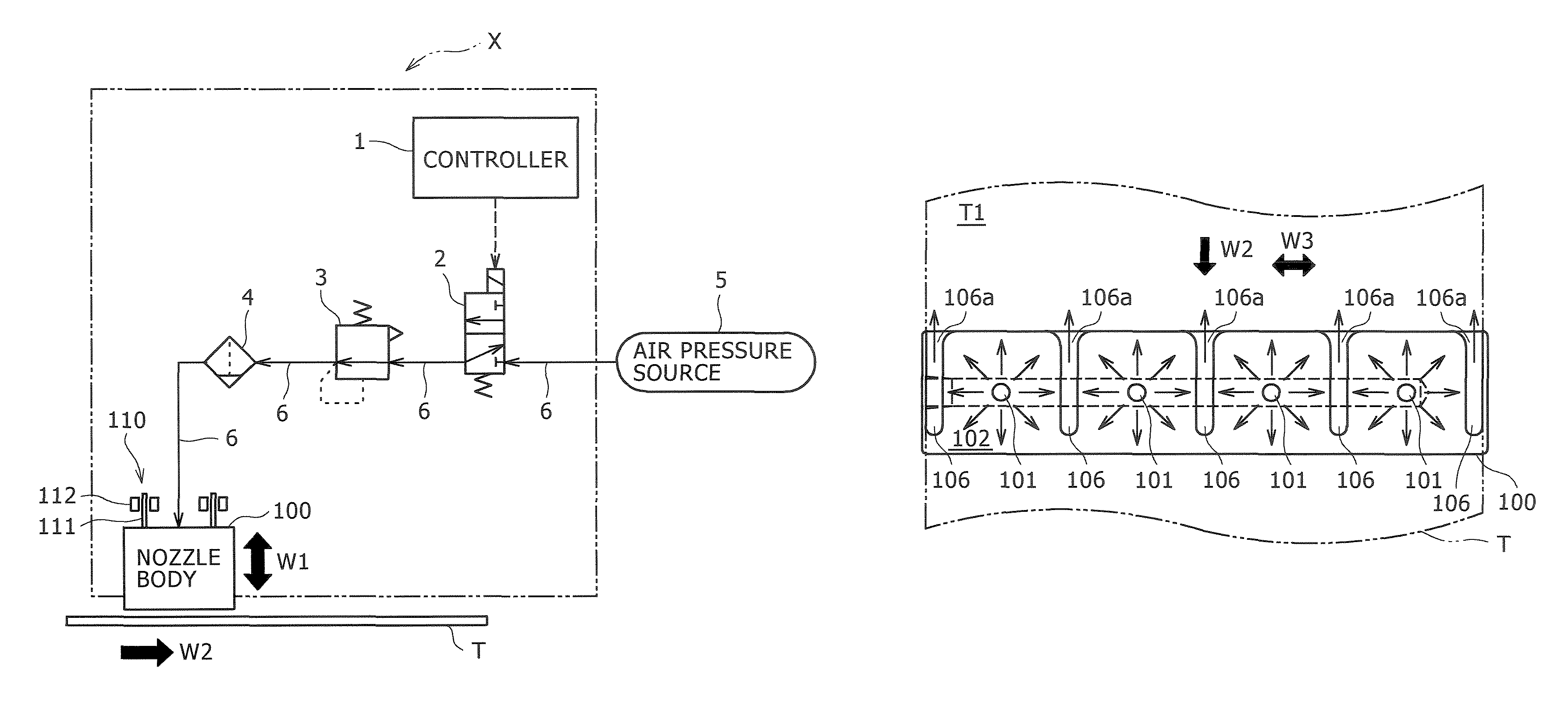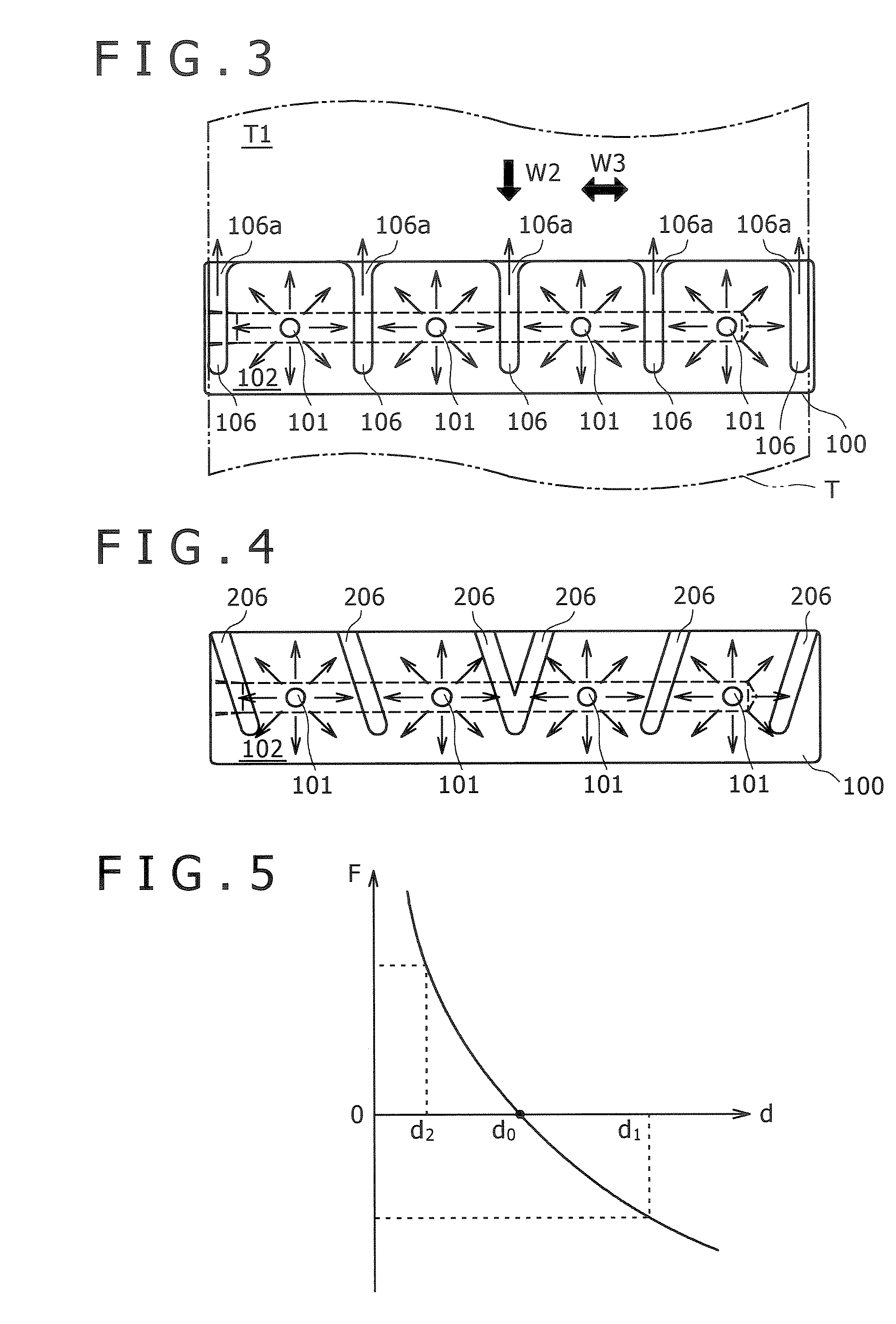Deposit removing device
a deposit removal and deposit technology, applied in the direction of cleaning equipment, lighting and heating apparatus, cleaning using liquids, etc., can solve the problems of reducing the spacing distance, the coefficient between the contact surfaces, and the plate-like member itself bursting, so as to reduce the spacing distance and efficiently remove the deposit
- Summary
- Abstract
- Description
- Claims
- Application Information
AI Technical Summary
Benefits of technology
Problems solved by technology
Method used
Image
Examples
example 1
[0074]Next, a deposit removing device X1 according to an example 1 of the present invention will be described with reference to FIGS. 11 and 12. FIG. 11 is a schematic longitudinal sectional view of the nozzle body 100a, and FIG. 12 is an arrow view of the nozzle body shown in FIG. 11. The same components as those in the above-described embodiment are designated by the same symbols, and descriptions thereof are omitted.
[0075]The deposit removing device X1 according to this embodiment is embodied into the deposit removing device X of the above-described embodiment in that, as shown in FIG. 11, and notably in FIG. 12, the deposit removing device X1 uses a nozzle body 100a in which the opposed surface 102 facing the top surface T1 has a groove 107. Although, in FIG. 11, grooves 106 (refer to FIGS. 2 to 4) formed in the nozzle body 100 are not shown, the nozzle body 100a may include the grooves 106.
[0076]As shown in FIG. 11, the groove 107 is formed in the direction perpendicular to the...
example 2
[0077]Next, a deposit removing device X2 according to an example 2 of the present invention will be described with reference to FIGS. 13 and 14.
[0078]In this example, a nozzle body 100b shown in FIG. 13 is used. In the nozzle body 100b of the deposit removing device X2, in its opposed surface, there are provided four jetting ports 101 that are arranged at spacings along the direction W3 substantially perpendicular to the conveying direction W2 of the plate-like member T (refer to FIG. 13) of the plate-like member T and the moving direction W1 (refer to FIG. 14) of the nozzle body 100b; and further, jetting port train 101b substantially same as a jetting port train 101a in a group of the above-described four jetting ports are arranged in parallel with the jetting port train 101a at predetermined spacings on the downstream side in the conveying direction W2. By juxtaposing such jetting port train 101a and jetting port train 101b, even when deposit that could not removed by the jetting...
example 3
[0084]Next, an example 3 will be described with reference to FIG. 15 (block diagram). A deposit removing device X3 according to this example is constructed to include the air release hole 109b provided in the nozzle body 100b (example 2, refer to FIG. 13); an oil separator 120 (one example of deposit separating / recovering means) that separates liquid or misty rolling liquid (one example of liquid deposit) contained in the air discharged from the air release hole 109b, from the air, and that recovers it in an oil tank 130 arranged outside the device; an injector 122 for guiding the separated rolling oil to the oil tank 130. Because other components of the deposit removing device X3 is similar to those of the deposit removing device X2, description thereof herein is omitted.
[0085]Possible types of the oil separator include various ones, but here, a device is exemplified that has therein an oil filter 120a for separating rolling oil alone from air, and that has a drain layer 120b with ...
PUM
| Property | Measurement | Unit |
|---|---|---|
| distance | aaaaa | aaaaa |
| distance | aaaaa | aaaaa |
| area | aaaaa | aaaaa |
Abstract
Description
Claims
Application Information
 Login to View More
Login to View More - R&D
- Intellectual Property
- Life Sciences
- Materials
- Tech Scout
- Unparalleled Data Quality
- Higher Quality Content
- 60% Fewer Hallucinations
Browse by: Latest US Patents, China's latest patents, Technical Efficacy Thesaurus, Application Domain, Technology Topic, Popular Technical Reports.
© 2025 PatSnap. All rights reserved.Legal|Privacy policy|Modern Slavery Act Transparency Statement|Sitemap|About US| Contact US: help@patsnap.com



